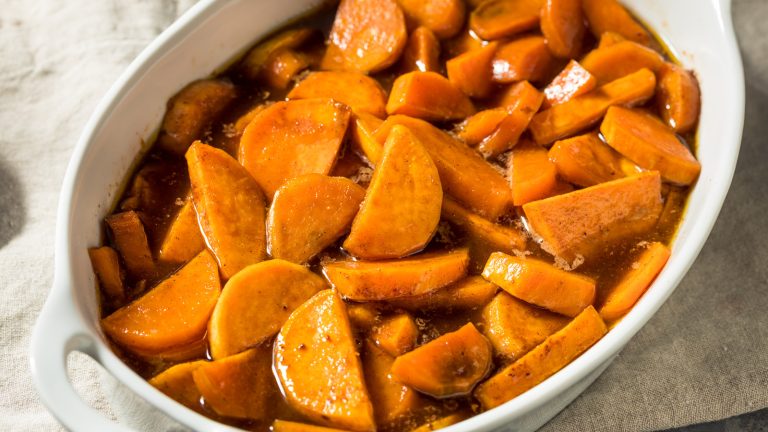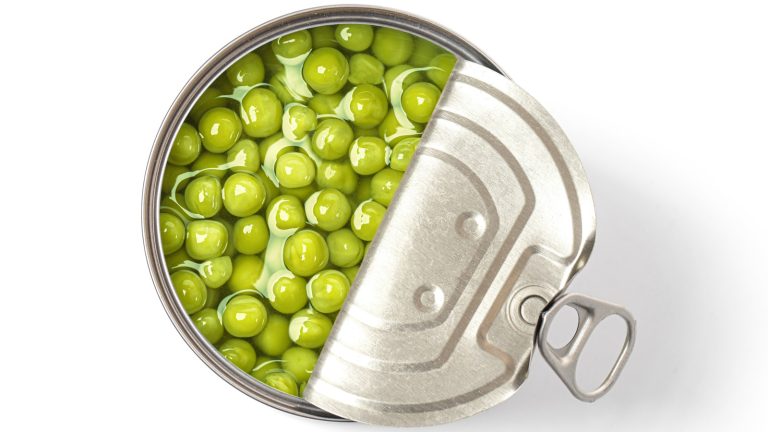What’s in a French fry? Potatoes, of course. These greasy, starchy treats have been a staple in fast food restaurants and frozen aisles for years, and we know why: They’re practically irresistible. But what if we told you it’s possible to reproduce that similar fry sensation using vegetables other than familiar, starchy potatoes?
There are plenty of reasons why you might want to swap out the humble potato for something a bit more creative. Whether you’re trying to avoid the high-carb make-up of a potato, have extra veggies on hand, or are simply out of spuds altogether, these fry fake-outs go way beyond the usual deep-fried potato (and are just as delicious). Don’t let those other non-potato veggies go to waste — check your veggie crisper drawer for one of these super substitutes. You may be much closer to a crispy fry than you thought. At the very least, they’ll fool the kids and, if you bake the veggies in your oven, they might be a tiny bit healthier, too.
Eggplant fries
Eggplant is synonymous with the classic ratatouille recipe or eggplant Parmigiana — but wait, there’s more! This veggie is slightly more versatile than you’d expect. Give it a good fry and taste the magic. Good thing eggplant is also healthy. Like many of the vegetables on this list, the purple-hued veggie also contains vitamin C for immune health and a good dose of fiber.
How do you make eggplant exceptionally delicious? It starts with olive oil. Well, almost. First, you need to peel the eggplant and cut it into spears. Then, give it a good salting to draw out the moisture. Let it rest for 30 minutes, and wipe it off. Lightly spray or brush your peeled, prepped, and ready eggplant with olive oil. Then, pop it into the air fryer or broiler until it turns golden. Or, you could dip it in egg, crumb-coat with panko breadcrumbs, and bake or fry. The result? Crispy, crunchy, eggplant-y goodness. You can even take it a step further by turning them into eggplant Parmesan fries. Now we’re talking.
Turnip fries
This winter vegetable could hit the sweet spot for that crisp, crave-worthy fry texture. Who knew turnips were basic peel-and-bake perfection? However, you can get to eating fries faster and skip the peeling if you find turnips without a waxy coating on the peel. Otherwise, in terms of their nutritional value, turnips stand strong with potential health-boosting vitamin C and body-supporting glucosinolates.
Peel (or not), and then cut this low-carb vegetable into your preferred fry shape. Get the oven ready with a high-temperature setting (425 degrees Fahrenheit works), and line your rimmed cookie sheet with foil. Next, mix your sliced turnips in a bowl with a heavy hand of olive oil. Add in salt, or try garlic powder, onion powder, or seasoned salt. Get creative and experiment. Pour onto the prepared baking sheet. Bake until your turnip fries turn a nice golden brown. You’ll want to flip them halfway through to ensure even baking.
Butternut squash fries
Butternut squash soup is a go-to autumnal staple, but this bright orange veggie could be your new favorite fry. Peeling butternut squash isn’t fun, but it will be worth it, at least if you want a less starchy french fry substitute. Heaps of fiber for your digestive health support, potassium to maintain bodily health, and a little calcium to help support bone (and tooth) health make this winter squash a fine choice.
After peeling butternut squash, slice it into your favorite fry shapes, keeping them as close to the same width as you can. Combine the squash slices with olive oil (or your favorite fat) and place on a rimmed and foil-lined cookie sheet to contain any juices. Bake at a high oven temperature (425 degrees Fahrenheit) until they look golden brown and a fork slides into the middle. Coat the fried squash with a little honey and dust it with a smidge of cinnamon for a sweet treat. Otherwise, stick with the basics. Salt that bad boy and enjoy warm.
Rutabaga fries
You’ve likely thrown rutabaga into a hearty stew or similar dish. But this low-carb root veggie is more than happy to sub in for a potato fry. Rutabagas offer up vitamin C, potassium, and fiber. That means they can help keep your immune system trucking along while potentially providing digestive support thanks to their fiber content and overall bodily health from the potassium.
Air fryer or oven, the rutabaga is a surprisingly easy veggie to crunch up, fry-style. It can be a little tricky to peel rutabaga, but remove all of the peel and slice it thin, with no more than a 1-inch width. Unlike other vegetables (we’re looking at you, potatoes), you don’t need to use much olive oil to get them to the proper crispy state. You’ll achieve the right kind of exterior crisp if you bake them at high heat or fry them in oil. Either way, they help to satisfy that fry craving.
Celery root fries
Celery root or celeriac — no matter what you call it, it’s delicious. Okay, it’s also a little bit ugly. But it’s what’s on the inside that counts (and it’s tasty). Celery root is another good source of vitamin K, which can help maintain bone health. It also provides a great source of vitamin C for immune system support. When you’re tired of the same old thing, give this unique veggie a try.
Although celery root makes a great onion substitute, when fried, you’ll think “potato” far more than you would “onion rings.” Begin by washing off the veggie. Then, peel and slice the celery root into thin strips. Dredge celery root in bread crumbs, season with rosemary, and fry to a crisp. Or, keep it simple. Toss celery root with olive oil and a little of your favorite seasoning, then bake at high heat (flipping halfway through) until done. Celery root is almost the stuff dreams are made of.
Zucchini fries
The smallest zucchini makes the best zucchini bread, but peeled and sliced zucchini makes for a darn good fry, too. Seriously, it’s time to give zucchini an upgrade. It’s crying for a change-up. Not only is zucchini low-carb, but it’s also high in fiber for digestive health and vitamin C to help maintain your immune system. Plus it’s not hard to find zucchini once summer is in full swing.
If you tried to make eggplant fries, you’ll find this process pretty close. But there’s none of the salting and waiting involved. Peel your zucchini and then slice it into long, thin strips. Break out the panko crumbs to achieve optimal crispy levels. Whisk an egg, dip the peeled zucchini into it, and season it with salt. Carefully place the breaded zucchini on a foil-lined rimmed baking sheet. Bake at high heat, checking your zucchini fries after 10 minutes (though it could take up to half an hour depending on the thickness of your fries).
Green bean fries
Green bean fries don’t hit the same notes as your typical french fry, but they are definitely far healthier. Plus, once your green bean fries are breaded and baked, you’ll get a crunchy and, dare we say, irresistible sensation. Consider green beans a fiber-friendly addition to your diet. Add in their vitamin K for bone health and vitamin C for immune support, and it’s easy to see why green beans are a body-healthy choice. Frying green beans just makes them taste amazing.
No messing with peels or slicing when you choose green beans for fries. Although you won’t need to boil green beans before frying as you do with starchy veggies if you want that crisp, you will have to bread them. Use panko crumbs. The large size of the bread crumb provides a bigger crisp than you’d get with typical breading. Plop your beans in a little bit of whisked egg, roll them in panko, and set in a high-heat oven (425 degrees Fahrenheit) until golden. These fries might not replace classic green bean casserole at Thanksgiving, but they’re sure to hit.
Jicama fries
Jicama isn’t a potato variation, but it is in the root vegetable family. It’s even lower in carbs (for any Keto dieters). Although people describe raw jicama as a cross in flavor somewhere between an apple, a pear, and a potato, it’s worth a fry. Bake jicama, and its flavor (and texture) mimic a potato. But tread carefully, as the skin and seeds of jicama are toxic. The root interior is the only part you can eat.
How do you achieve potato-like fries? The process doesn’t differ too much from typical spuds. Peel the skin, and slice jicama into thin fry-like strips just as you would a potato. Place into a pot of boiling water until softened, drain, and then toss with olive oil. Air fry at 400 degrees Fahrenheit until golden (roughly 25 minutes). Or, fire up your oven to 425 degrees Fahrenheit. Grab vegetable oil or your favorite fat, coat the prepped jicama, and place it onto your foil-lined rimmed baking sheet. Bake until the fries are softened and look golden in color.
Carrot fries
Carrot fries
If you are a fan of roasted carrots (what pot roast recipe would be complete without them?), you wouldn’t think carrots would properly crisp up. But you’d be wrong, at least if you use a high enough heat (at least 425 degrees Fahrenheit) when baking them. Carrots are a healthy swap for potatoes. High levels of beta-carotene could help your eye health, while their potassium content can help support a healthy heart.
Frying or baking carrots, however, is a game-changer. You’ll need to peel and slice the carrots first. Maintain even slices to ensure even baking. Then, line a rimmed cookie sheet with oil or prep your air fryer. If you add a drizzle of olive oil (or your favorite fat) and a little salt to season them, it only takes 10 minutes (at high heat) to complete a batch of carrot fries. Funny enough, your carrot fries will look a whole lot similar to another favorite fry: sweet potato. Tip: Sprinkle with some sugar and cinnamon for a sweet dessert fry.
Yuca root fries
Yuca root is not yucca (a perennial ornamental plant) or yucky; It’s yuca root. This tuber, also termed cassava, is a dietary staple in Africa and South America and is gaining ground in other parts of the world due to its healthy nutritional profile. How healthy is yuca root? It holds a high amount of vitamin C to help keep your immune system humming along. Yuca root is also a good source of potassium, which can help maintain heart health.
Don’t rush the “cook until done” process on this one. Raw yuca root has cyanogenic glycosides, a toxic chemical that changes to cyanide. Peel, slice the root into your preferred fry shape, place into boiling water and boil the slices until softened. Blot with a towel to dry and deep fry yuca root for crispy fries. You’ll know it’s finished cooking when it looks golden brown, and just like checking a potato for doneness, you can easily push a kitchen tester through it. Completely cooking yuca root eliminates its former toxicity, while boiling removes starch (to help prevent scorched fries).





